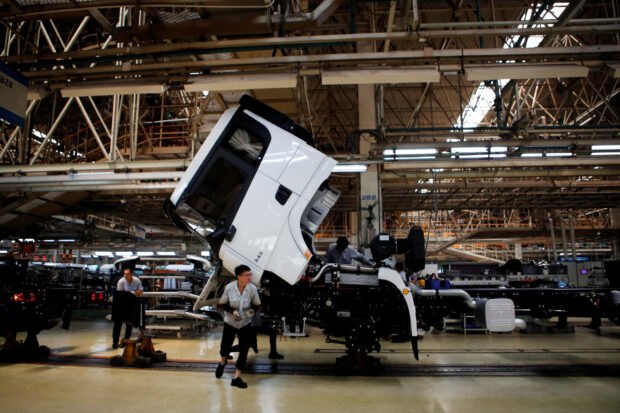China Jan-Feb industrial output, retail sales beat expectations

Employees work on the trucks production line during an organised media tour to the Shaanxi Automobile Group factory in Xian, Shaanxi province, China May 17, 2023. REUTERS/Florence Lo/File photo
BEIJING — China’s factory output sped up in the January-February period and beat expectations, marking a solid start for 2024 and offering tentative relief to policymakers who are seeking to shore up faltering economic growth.
Industrial output rose 7 percent in the first two months of the year, data released by the National Bureau of Statistics (NBS) showed on Monday, above expectations for a 5-percent increase in a Reuters poll of analysts and faster than the 6.8 percent growth seen in December. It also marked the quickest growth in almost two years.
Retail sales, a gauge of consumption, rose 5.5 percent , slowing from a 7.4-percent increase in December. Analysts had expected retail sales to grow 5.2 percent .
READ: China’s consumer prices suffer steepest fall since 2009
The eight-day Lunar New Year holiday in February saw a solid return of travel, which supported revenue of tourism and hospitality sectors.
Fixed asset investment expanded 4.2 percent in the first two months of 2024 from the same period a year earlier, versus expectations for a 3.2-percent rise. It grew 3 percent in the whole of 2023.
Together with better-than-expected trade data and consumer inflation, Monday’s indicators will provide some temporary encouragement for policymakers as they try to shore up growth in the world’s second-largest economy to keep it on track for an expansion of around 5 percent this year.
READ: China’s Jan-Feb imports and exports beat forecasts
But analysts say achieving such growth would be more challenging than last year, which had a lower base effect due to COVID curbs in 2022. Moreover, the property sector remains weak and could continue to be a major impediment to a solid recovery this year.
Property investment slid 9 percent year-on-year in January-February, compared with a 24-percent fall in December but still far from levels of reaching stability.
The NBS publishes combined January and February industrial output and retail sales data to smooth out distortions caused by the shifting timing of the Lunar New Year. Activity picked up in the first two months of 2023 as COVID curbs were lifted, which may create a less flattering base effect for this year’s data.
Premier Li Qiang promised at the annual parliamentary meeting earlier this month to transform the country’s growth model and defuse risks in the property sector and local government debt.
China plans to issue 1 trillion yuan in special ultra-long term treasury bonds to support some key sectors and set a higher quota for local government special bond issuance this year.
READ: China to cut banks’ reserve requirements to boost economy
The country’s central bank governor Pan Gongsheng also said at a press conference on March 6 that there was still room to cut banks’ reserve ratio requirement (RRR), following a 50-basis points cut announced in January, which was the biggest in two years.
The central-bank backed Financial News on Friday said the bank “has no intention of actively draining cash,” after leaving a key policy rate unchanged while withdrawing cash from a medium-term policy loan operation for the first time in 16 months.
Authorities in January launched a “whitelist” mechanism, asking state banks to boost lending to residential projects. More big cities including Shanghai and Shenzhen have also eased purchase curbs to lure homebuyers.
The job market worsened with the nationwide survey-based jobless rate at 5.3% in January-February, up from 5.1 percent in December.